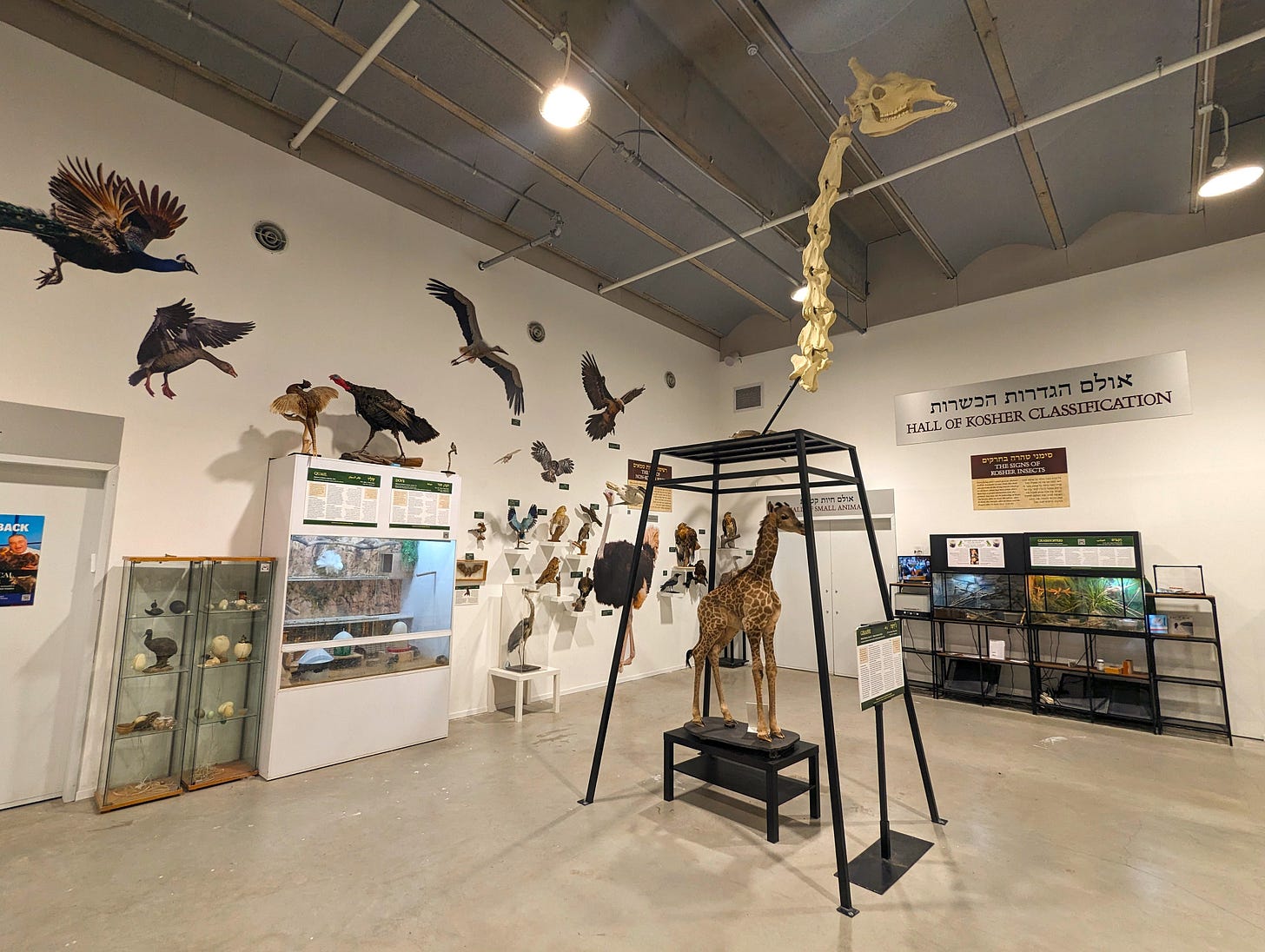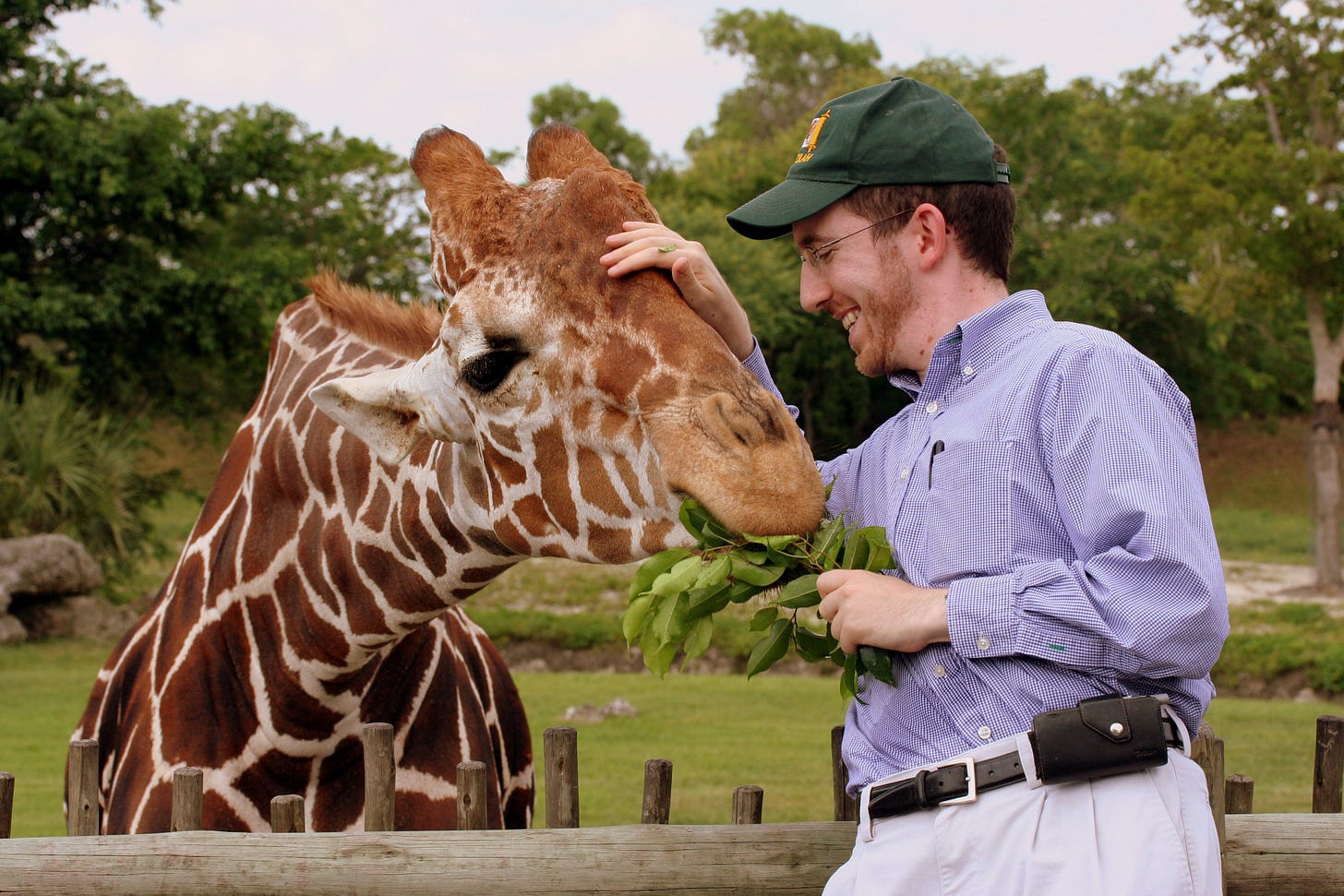Is it a Sin to Kill a Giraffe?
If giraffe is kosher, why don't we eat it?
This week’s Torah reading, Re’ay, lists the laws of kashrut. It includes a list of kosher animals, the last one of which is called the zemer, which some identify as the giraffe. Whether or not the giraffe is actually the zemer (see The Torah Encyclopedia of the Animal Kingdom), it’s certainly a kosher animal. It has split hooves and chews the cud. It even (as can be seen on the giraffe skeleton at the Biblical Museum of Natural History) lacks upper incisors, which the Talmud observes is a sign of kosher animals.
Several people have excitedly told me that a giraffe was shechted at the Ramat Gan safari many years ago. That’s not exactly what happened. I know, because I was there! The “shechitah” was only a halachic exercise - the giraffe was already dead (it was a stillborn) and thus could not be eaten.
So why don’t we eat giraffe? We ask that question on the museum tour, and we get a lot of wrong answers.
We’ve had about a hundred thousand visitors tell us that it’s because we don’t know where on the neck to shecht it. This is a myth - anywhere on the neck is fine. You’ve got more choice of where to shecht with a giraffe than with any other animal!
Nor is it because one needs a mesorah. Aside from the unusual view of the Chazon Ish, normative halachic opinion is that no mesorah is needed for mammals which possess the kosher signs. That’s why you can buy bison with OU kosher certification.
Nor is it because of practical difficulties in shechting such a large animal. While turning a giraffe upside down would be cruel, impractical and would likely kill it before shechita, veterinary surgeons have developed ways to restrain and work with giraffes, and these could be implemented for shechitah.
The real reasons why we don’t eat giraffe are different.
First, think about why non-Jews don’t eat giraffe. It’s just not commercially available! It’s true that at the Biblical Museum of Natural History we specialize in serving non-commercially available creatures at our exotic banquets. And I have looked into serving giraffe, and I even found out a way in which we could do it - I had a shochet in Africa ready to go! But unfortunately we couldn’t proceed to do it, for a combination of reasons.
It’s not so simple to just buy a giraffe. Wild giraffes live in nature reserves and are protected. There has been a large decline in their number over the last few decades, and from 2016 they have been classified as vulnerable to extinction.
Now, although capturing and slaughtering a wild giraffe is illegal, there are legal ways to buy a giraffe for slaughter. There are several countries in Africa in which there are game parks where you can buy a license to hunt a giraffe. And, from a conservation standpoint, it’s not at all the case that such enterprises are bad for giraffes. After all, the primary challenge for conservation is protecting large tracts of nature from poachers, from human development and from being turned into grazing land for cattle. This requires a lot of money (and incentive) to buy land and protect it. People who buy hunting licenses are funding such operations. An enormous game reserve is a net benefit for animals, including giraffes, notwithstanding the occasional individual killed by a hunter who paid a lot of money to do so.
But we couldn’t do it, for a rather frustrating reason.
Several years ago, a woman from Kentucky hunted and killed a giraffe. While the idea of killing an animal for fun and posing with its body is nauseating, she did it in the most objectively justifiable way. She bought a hunting license and helped pay for giraffe habitat. The specific giraffe that she purchased was old and sterile. It had been killing younger, fertile giraffes! And the meat all went to local poor Africans, who need to eat.
Nevertheless, the public backlash was enormous, with the woman receiving death threats. For many people, there is never a justification for killing a beautiful animal. And giraffes are certainly very beautiful animals.
(This relates to the general difference between conservationists/scientists and animal lovers/rights activists, which has many ramifications. For example, pet cats are absolutely devastating to wildlife, but many animal lovers would not hear of killing or outlawing them. People get outraged about cockfighting, and yet such carefully raised roosters lead lives that are vastly superior to the horrific lives of the chickens that we eat.)
The Copenhagen Zoo learned the same lesson. They had a giraffe which, for genetic reasons, could not be exposed to other giraffes for breeding. The European Association of Zoos and Aquaria recommended euthanasia, which is standard practice in such cases, and was supported by animal welfare organizations. But the Copenhagen Zoo made the mistake of doing so in public and feeding the carcass to the lions in front of the visitors! It was a complete PR disaster and the staff received death threats. Lions eat giraffes in the wild, but many people absolutely do not want to see lions engage in such natural behavior.
We cannot afford to make the same mistake. It’s simply not the case that there’s no such thing as bad publicity. As it is, the museum performs a difficult balancing act. While our Hall of Kosher Classification is of tremendous educational value, and is greatly appreciated by all religious visitors and many secular visitors, there are some secular visitors who do not like what they see as the glorification of killing animals.
For this reason, we have to be careful with the promotion of our forthcoming Feast of Kosher Curiosities on erev Sukkos. It’s an event with tremendous educational value, and it’s a fundraiser in support of an institution which among its benefits includes teaching people to appreciate and protect the natural world. And all the animals being served have led lives that were far superior to those of the chickens that are sold at supermarkets and those that lay eggs for us (and which really shouldn’t be considered to be conforming to the highest standards of Torah law). But some people are of the belief that eating non-domestic species is morally wrong. (Interestingly, the Torah law that one must cover the blood of a wild animal is explained by some to mean that one must show greater respect for the life of an animal that was not designed to be food.) If we were to serve giraffe, it would get a lot of publicity, and there would be tremendous backlash.
So, giraffe will not be, and will probably never be, on the menu. But several other unusual species will be! Book your seats at this link.






A rebbe of mine who was a very big talmid chochom used to say, "The only reason why we don't eat giraffe is the same reason why the goyim don't eat giraffe. Because giraffe meat is tough and gross!"
Many Arabs eat camels. I've seen the sh'chita done. They only shecht young camels - up to about a year or so, when they're only about 2m tall. Why? Because beyond that, they're just too tough to eat.
I assume that giraffes would be the same.